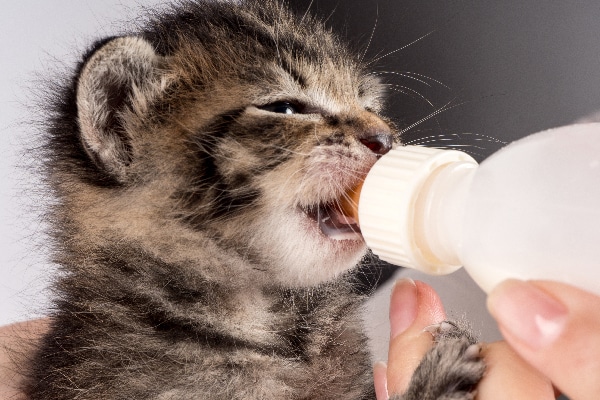So, you found a stray kitten … but the next step isn’t simply taking him home with you. What do you feed a stray kitten? Where should you take stray kittens if you can’t care for them yourself? And how do you determine if the kitties are in fact strays in the first place?

So … you’ve found a stray kitten or kittens? Here’s what to do next. Photography by Sun_apple/Thinkstock.
Investigate — does the stray kitten have a mother?
Helping orphaned kittens will first require some detective work. One of the biggest mistakes people make when finding stray kittens is taking them away from their mother. Neonatal kittens are still nursing and need to be fed frequently, so they should be kept with their mother, if possible.
Here’s how to assess the situation:
- Are the kittens sleeping comfortably? The mother is probably coming back.
- When you recheck on them, are any of them missing? The mother is moving them.
- If they’re often found sleeping, then the mother is caring for them.
- To be absolutely sure, sprinkle some flour around where the kittens are located and look for paw prints upon your return. If the mother is in the picture, let them be. In approximately eight weeks, go back and TNR (trap/neuter/return) the whole family.
What to do if the stray kitten does not have a mother
If you have determined the stray kitten (or kittens!) does not have a mother, his greatest chance for survival begins with you. The first thing you’ll need to do is capture the stray kitten. For some kittens, this is as easy as reaching out and scooping them up. For others, you may need to contact a local animal society or shelter to obtain the humane traps often used in TNR. Simply place the trap out with some food inside, and wait nearby. The kitten should wander in and trigger the trap to close its door. Kittens do not get hurt in the process!
Next, get the stray kitten to a veterinarian for a checkup ASAP. If the vet’s office is closed, you’ll have to start his care right away. Even if you can’t foster a stray kitten long term, you’ll be a lifeline during this first phase of rescue.
If you cannot foster the stray kitten for any amount of time, find a no-kill animal shelter. The No Kill Network has a list of organizations by state, and Adopt-A-Pet lists cat rescues.
Containing and monitoring the formerly stray kitten is key to his health and well-being. A dog crate is perfect. To keep him toasty, place a covered heating pad in his crate and keep the room temperature at 75 degrees. The heating pad should cover only half the crate so he can get away from it. Watch for panting — you don’t want him to get overheated either. A cold or limp kitten indicates a medical emergency.
Feeding schedule for kittens by weight and age

Very young kittens must be bottle fed. Photography ©Dobroslav Hadzhiev | iStock / Getty Images Plus.
Determining the age of the stray kitten right away is imperative. His age will mandate what he’ll eat as well as how much and how often.
Using a postal scale, here’s a quick guide:
- Under 1 week old: kitten weighs less than 4 ounces. Feed formula: every two to three hours.
- 7 to 10 days old: kitten weighs 4 to 6 ounces. Feed formula: every two to three hours.
- 10 to 14 days old: kitten weighs 6 to 8 ounces. Feed formula: every three hours.
- 14 to 21 days old: kitten weighs 8 to 12 ounces. Feed formula: every four hours.
- 4 to 5 weeks old: kitten weighs 12 ounces to 1 pound. Feed mix of gruel/formula/kitten kibble: every four hours.
- 6 to 7 weeks old: kitten weighs 1 pound to 1 pound and 8 ounces. Feed mix of kitten kibble and wet food four times a day.
- 8 weeks old: kitten weighs one and a half to 2 pounds. Fully weaned.
Pro tips for proper kitten care
Kitties start weaning at a month old. Until then, he’ll need to be bottle-fed kitten formula. In a pinch, you can use goat milk but only for a short time.
Pet supply stores and many grocery stores will have all you’ll need:
- Kitten formula
- Bottles
- Rubber nipples
- Cleaning supplies
Only bottle-feed the kitten with his belly touching the table (never while on his back). Experts recommend letting the kitten eat the warmed-up formula until he’s full. It usually takes less than 15 minutes.
Kittens will need help eliminating urine and feces until they are approximately a month old. After each feeding, use a warm, damp washcloth to gently rub his anus until he goes. You can introduce a litter box filled with non-clumping litter at 3 weeks old.
Find a home for the stray kitten
At 8 weeks old, the kitten is ready to be spayed or neutered and placed into a loving home. There are many ways to find the stray kitten a home — check out bestfriends.org for a guide of best practices. Unless, of course, he or she is already home. Kittens are, after all, irresistible!
Thumbnail: Photography ©ConstantinCornel | Thinkstock.
This article was originally published in 2017.
